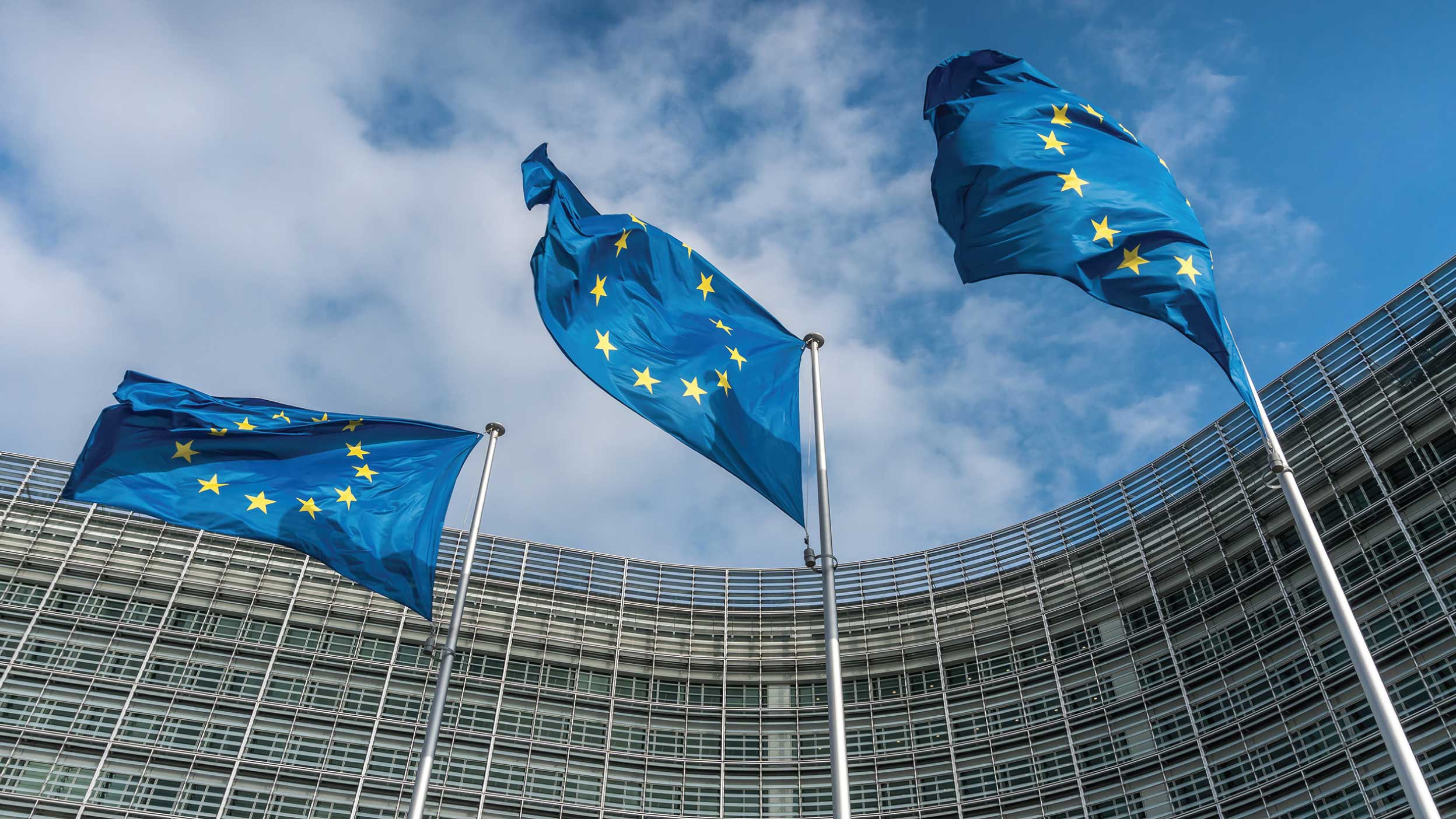
Weekly Market Compass European stock markets surge as US stock market sags
European nations prepare to invest in defense and infrastructure, while the US faces the possibility of recession brought on by government spending cuts.

The coronavirus pandemic is spreading in Europe, the UK, Canada, and the US — and economic activity is grinding to a halt in some sectors as discretionary spending and activity have been sharply reduced in favor of basic needs. Real-time indicators of demand such as restaurant patronage, traffic, and cellphone mobility data are all down dramatically on a year-over-year basis across several major regional and local economies.
The market response has been equally sharp. Stocks rose and fell dramatically last week, especially on Thursday when the Dow experienced its largest drop since 1987 and the STOXX® Europe 600 Index experienced its largest drop ever. The bond market experienced dramatic volatility as well, with the 10-year US Treasury yield falling to as low as 0.4% last week. 1 Markets appear to be experiencing a lack of confidence in the policy responses in Europe and the US, and that seems to be continuing into this week.
One of the questions we have been receiving lately is: What is the appropriate policy response? There’s a lot embedded in that question. In the past, we have written about the importance of a three-pronged policy response to coronavirus: 1) public health policy to contain the virus, 2) monetary measures to ensure financial liquidity and functionality, and 3) fiscal support to contain the real economic damage. Combating the crisis from these three angles remains critical today — here’s how we assess progress in these areas across the globe.
China’s measures — locking down parts of the country — have been described as draconian, but they were effective: China’s new infections have dwindled. The ongoing issue here is that Western democracies — which prize freedom of association, movement, and choice — are reluctant to take or enforce such measures. This in turn implies that the virus may be able to spread further before it is contained in these areas.
South Korea has also taken impressive measures to stem the spread of the virus in its country, including extensive, early, and exhaustive testing — its most innovative being drive-thru coronavirus testing. This approach appears to have been very successful, both in containing the virus and in containing fatalities, thanks to early action and mobilization of treatment resources.
What appears to be happening across the EU and the US is a gradual but uneven movement toward adopting China-type policies that would lock down non-essential economic activity to stop the virus. Embracing these policies would imply that recession will be required to contain the virus (which has been named COVID-19). The data released in the last day on Chinese economic activity is a reminder of the economic damage that can come from attempting to control the contagion: China reported the worst monthly economic data on record due to the COVID-19 national lockdown and business shutdown. Investments, retail sales, and industrial production all came in much lower than consensus. The hope would be that a V-shaped recovery would follow, with a sharp, quick upturn following the bottom. Although, based on what we are seeing in China, the recovery appears to be less quick and sharp than we would like to see.
We worry that the paroxysms in global financial markets reflect a sudden perception that neither China’s draconian but effective containment strategy nor South Korea’s effective testing and treatment approach is feasible in the West, despite movements toward both strategies across a variety of Western economies, and that therefore a more drawn-out recession and gradual recovery lies ahead.
For example, Italy was proactive in testing citizens, but appears to have had more difficulty in encouraging people to stay home and self-isolate in the early weeks of the virus. Several weeks ago, it made the dramatic decision to lock down the northern part of the country, and then more recently expanded the lockdown to the entire country, with essentially just grocery stores and pharmacies remaining open. However, it appears that both the regional and national lockdowns were not fully adhered to, initially, though compliance did improve over time as the gravity of the public health threat became apparent. The coronavirus mortality rate in Italy2 is nearly 7%, a staggering figure, as the health care system is overwhelmed — though we note that as testing widens, and more people with perhaps milder symptoms are being identified, the mortality rate seems to be falling.
Elsewhere in the West, France appears to be following Italy’s pattern — widening lockdowns but with only gradual public adherence. Spain is already on lockdown, and national borders are being closed across the EU. And the UK and the US have had slower starts in combating the virus.
The US thus far has had very limited testing. It is only now mobilizing its efforts to contain the virus by heeding warnings from the Centers for Disease Control (CDC) and practicing what is called “social distancing.” Many sporting events, colleges, and school districts — and even theater on Broadway — have closed in the last week, but many fear that the US response may be later than ideal.
The UK response has been relatively laissez-faire, thus far reasoning that health care resources and containment measures should be targeted, rather than adopting widespread testing and containment. However, UK and US policies are becoming more proactive and widespread under public and international health policy pressure.
Central banks are moving to keep the financial system stable by ensuring that there is enough liquidity to keep banks and financial markets functioning, thereby supporting businesses and households during this downturn. We have seen signs of market dysfunction, including reduced market liquidity and counterintuitive movements as many market participants moved in the same direction (for example, there have been occasional, atypical declines in both US Treasuries and risk assets like equities). This reflects a “dash-for-cash,” and we believe the US Federal Reserve (Fed) and other central banks are absolutely right to satisfy this extreme demand for cash. We expect such monetary policy measures can help maintain financial system stability, a key requirement for the rest of the policy response, and for eventual recovery.
The Fed has been quite proactive, providing an emergency rate cut of 50 basis points in early March, and then providing another emergency rate cut of 100 basis points on March 15. In addition to the latest rate cut the Fed announced several other measures:
We believe that the Fed’s reduction in the capital buffer should be a positive — the Bank of England (BOE) and European Central Bank (ECB) signaled cuts in the capital buffer last week as well — and that reducing the rate on the discount window should help.
China’s monetary response has been multi-faceted. To counter the economic shock from the coronavirus, it provided a series of smaller, targeted liquidity injections to support relending measures, boost confidence through regulatory forbearance, and lower funding costs to keep smaller companies afloat. It has lowered the reserve ratio requirement and also provided policy rate cuts.
Interestingly, the People’s Bank of China decided on March 16 to not provide more easing, although it was widely expected, perhaps signaling that monetary policy support has already been adequate now that the crisis is subsiding in China. However, this also suggests that China may not offer enough stimulus to provide a major lift to the rest of the world (unlike its big credit and investment pushes in 2009-10 and 2015-16, which contributed strongly to global recovery). We believe the decision to refrain from further easing is appropriate, because China’s and the world’s long-term growth will be better served, in our view, by maintaining debt stabilization policies rather than rapid debt growth. This means the onus will be greater on other major central banks, and on fiscal policy.
Some other aspects of the central bank response could be improved. Words from central banks matter, as they did during the Greek debt crisis when then-ECB president Mario Draghi pledged to do “whatever it takes” to support the economy and markets. Unfortunately, current ECB president Christine Lagarde spooked markets last week with her comments in a press conference on Thursday. Lagarde said that the ECB was not there to “close spreads” between countries, suggesting the ECB would not be supportive of Italy. In addition, she suggested she would not advocate for “whatever it takes” to support markets. This was far from reassuring, and she had to walk back those comments because of the negative impact they had.
In addition, it’s important to remember that central banks can cause more fear than calm if their decisions are dramatic and occur during emergency meetings — as we have seen with the Fed’s decisions this month.
In the last decade, central bankers have bemoaned the absence of adequate fiscal stimulus. However, that situation must change for economies to lessen the impact of recessionary policies intended to control the virus.
In China, fiscal policy has focused on lowering corporations’ operating costs and ensuring local governments are well-endowed with funds via bond insurance. We expect China’s fiscal stimulus to be significant, led by special quota bonds (totaling 3.5 trillion renminbi) to support provincial infrastructure projects, and also including diminished tax and fee cuts compared to last year. China has implemented targeted programs such as subsidized loans in order to keep companies running and paying workers while factories were shut down.
The Italian government is taking all manner of drastic economic measures to soften the economic blow of coronavirus, such as suspending mortgage payments across the country. Lenders are offering debt holidays to small firms and families. On March 15, a very comprehensive fiscal stimulus package was signed that included fiscal support for households (social welfare payments) as well as to SMEs (small to medium-sized enterprises).
The UK announced cuts in business taxes and other support measures for SMEs, as well a significant infrastructure spending stimulus plan last week, which was well-received by markets.
The US declared the coronavirus a national emergency last week, freeing up to $50 billion to be spent on fighting the crisis. Also in the works is a fiscal stimulus bill that has passed the US House of Representatives and is awaiting approval by the US Senate and the president. We view this as an initial response that will likely need to be followed by more fiscal stimulus.
And, finally, European Commission President Ursula von der Leyen announced that it is ready to support widespread fiscal stimulus for euro nations. This was an important development, especially given that a number of policymakers used the term “doing whatever it takes,” harkening back to Mario Draghi’s famous words during the Greek debt crisis.
At some point, the US federal government may need to do another Troubled Asset Relief Program if defaults start to rise and banks come under pressure. We believe the government should probably signal that it stands ready to do that if needed (though some may say that sending such a message may trigger a solvency problem that doesn’t yet exist). Illiquidity becomes insolvency very quickly for banks and even for less-leveraged firms if they can’t rollover their debt or lines — as well as for households that don’t get paychecks.
Health care policy. One size does not fit all when it comes to the health care response. China was able to be extremely effective in its containment measures, but it would be very difficult for Western democracies to achieve similar results. However, the more that citizens can self-isolate for an extended period of time, the more likely that governments will be able to “flatten the curve” (in other words, slow the infection rate to a level that doesn’t overwhelm hospital resources). That, however, requires effective support from monetary and fiscal policies, because such health care policies would have a recessionary effect.
Monetary policy. Monetary policy must continue to keep banks liquid and markets functioning, possibly for an extended period. The bottom line is that helping banks to extend loans and give mortgage/loan holidays is critical. Both the Fed and BOE are helping with this through their recent decisions. We hope that the crisis can be contained rapidly, but are concerned that the slower start and weaker mass testing compared with Asia, and lower enforceability of containment measures compared with China, points to more like a two-quarter than one-quarter shock, with some risk of an even longer containment period. If the economic fallout is extended, as we fear, because recessionary public health policies are required to save lives, the Fed may need to engage in facilities reminiscent of the global financial crisis, such as ensuring firms can roll over commercial paper for working capital needs.
All that said, we must stress that we don’t believe the Fed or the BOE should move to negative rates — a policy that has proven ineffective in the eurozone and Japan, and has many bad side effects, including undermining banks long term. Above all, we would prefer a more aggressive fiscal policy if the Fed gets to zero and bond yields go and stay below zero, rather than negative Fed rates (which could validate and hold long-term yields below zero on a running basis).
We believe negative Fed policy rates and bond yields, if they persisted for a long time as in Europe and Japan, would be a very disturbing signal about the long-run outlook. Negative rates and yields would mean that money today is worth less than money in the future.3 Therefore, persistently negative interest rates could imply that the markets expect a smaller economy (through negative real growth) in the future and/or lower prices (and hence a smaller nominal economy). Such market pricing and expectations could become self-fulfilling, as people and firms might delay consumption and investment in the expectation of lower prices in future, or avoid such decisions entirely because they expect the economy to shrink.
This may be a time for some central banks to explore more experimental monetary tools such as helicopter money, which could simulate fiscal stimulus.
Fiscal policy. Governments need to provide adequate support to companies and households so that they can follow health guidelines (staying in rather than going out shopping and dining) and economically survive the crisis through the protection of household and corporate cash flows. We would like to see governments give corporate tax holidays or rebates and improve safety nets for workers (such as guaranteed sick pay). Again, both the UK and US are moving in this direction. We believe governments should indicate a willingness to make people and firms temporarily whole with zero interest rate loans to cover their liabilities. (If there is a V-shaped recovery, this could be repaid over time; but if not, it could be simply monetized and cancelled.)
We would also like to see monetary and fiscal coordination that is aimed at restoring price and financial stability expectations in the immediate future, and giving time to affected households, firms, financials, and sovereigns (as was illustrated in the global financial crisis, each liability is an asset to someone else).
In addition, we believe major governments should lay out a plan for coordination with the World Health Organization, International Monetary Fund, and the World Bank in case there are waves of the virus, or it starts to propagate in countries with even weaker public health systems, especially in emerging markets. We will continue to monitor the emerging market space because of the oil price fall (emerging market energy firms have issued a lot of debt recently as have US shale oil producers) and because the virus seems to be taking root in some emerging market countries and could challenge their health systems and economies too.
International cooperation. We would like to see greater international coordination and cooperation to signal that national governments see this crisis as a shared shock with shared solutions, instead of focusing on mainly national solutions with borders going up to protect national populations. Such barriers may be an inevitable counterpart of domestic lockdowns, but vaccine development efforts, information about the virus and its spread, as well as the longer-term outlook for recovery would be boosted by clear signaling that governments are prepared to work together as they did in the global financial crisis. The major central banks moved in this direction over the weekend with coordinated easing and shared dollar swap lines. The public health and fiscal authorities, as well as political leaders, should show the same resolve and cooperation, in our view, to instill both public and market confidence.
In short, markets want to see that policymakers are willing to step in where markets are failing. They want to see functional governments, independent central banks, and global coordination among policymakers. We believe this is needed to help prevent a crisis in confidence and help economies and capital markets get past the pandemic.

European nations prepare to invest in defense and infrastructure, while the US faces the possibility of recession brought on by government spending cuts.

The US economy appears to be slowing quickly as consumers brace for tariffs, higher prices, and a possible government shutdown.

Unemployment concerns and rising inflation expectations contribute to falling US consumer sentiment, while the German election could be a positive catalyst for European equities.